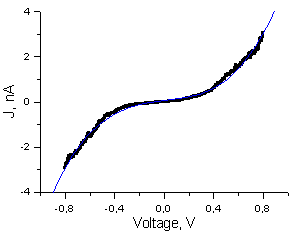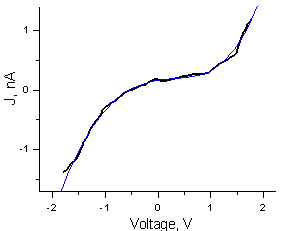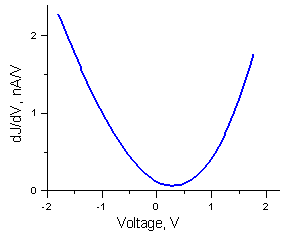1.3.1 Current-Voltage Characteristic
Measurement of relation between tunneling current and probe-sample voltage is carried out in
 spectroscopy mode. The
spectroscopy mode. The
 spectroscopy is based on the dependence of tunneling current on number of electron states
spectroscopy is based on the dependence of tunneling current on number of electron states
 , forming a tunneling contact of conductors, in the energy range from the Fermi level
, forming a tunneling contact of conductors, in the energy range from the Fermi level
 to
to
 (Fig. 1), which at
(Fig. 1), which at
 gives (see (7) in chapter 1.2.1)
gives (see (7) in chapter 1.2.1)

(1)
Thus the tunneling current dependence
 at constant tip-sample separation
at constant tip-sample separation
 represents an allocation of torn bonds as well as other electron states corresponding different energies, i.e. energy band structure of either tip or surface. Function
represents an allocation of torn bonds as well as other electron states corresponding different energies, i.e. energy band structure of either tip or surface. Function
 , which was introduced in (6) of chapter 1.2.1, depends on electron state density of phase space plane which is normal to tunneling direction at given
, which was introduced in (6) of chapter 1.2.1, depends on electron state density of phase space plane which is normal to tunneling direction at given
 .
.

Fig. 1. Model of MIM system with an arbitrary shape potential barrier.
Positive potential is applied to the right metal.
Using expression (1) and
 curve at constant tip-sample separation
curve at constant tip-sample separation
 , it is possible to compute the density of electronic states:
, it is possible to compute the density of electronic states:

(2)
Thus, inspection of
 and its derivative
and its derivative
 curves allows to investigate energy levels distribution with atomic resolution. It is possible to determine a conductivity type, in particular for semiconductors – to detect the valence band, conductivity band and impurity band [1-3].
curves allows to investigate energy levels distribution with atomic resolution. It is possible to determine a conductivity type, in particular for semiconductors – to detect the valence band, conductivity band and impurity band [1-3].
According to (2) and (3) from chapter 1.2.2 tunneling conductivity
 does not depend on applied voltage
does not depend on applied voltage
 in case
in case


(3)
at
 relation between
relation between
 and
and
 is parabolic
is parabolic

(4)
On Fig. 2, 3 experimental dependences
 ,
,
 , which were measured for Pt and HOPG samples and Pt-Ro probe using STM Solver P47, is shown. Experimental data are in good agreement with the theoretical predictions (1)–(4).
, which were measured for Pt and HOPG samples and Pt-Ro probe using STM Solver P47, is shown. Experimental data are in good agreement with the theoretical predictions (1)–(4).

Fig. 1a. Experimental (points) and theoretical (solid line)
dependences
 for Pt
for Pt

Fig. 1b. Experimental dependence
 for Pt
for Pt

Fig. 2a. Experimental (points) and theoretical (solid line)
dependences
 for HOPG
for HOPG

Fig. 2b. Experimental dependence
 for HOPG
for HOPG
Summary.
- Tunneling current-voltage characteristic represents number of electron states and their distribution in energy spectrum of electrodes which creates tunneling contact.
- Differential conduction
 is proportional an electron state density. For metals at low voltages
is proportional an electron state density. For metals at low voltages
 does not depend on applied voltage (3). At intermediate voltages the relation between
does not depend on applied voltage (3). At intermediate voltages the relation between
 and applied voltage is parabolic (4).
and applied voltage is parabolic (4).
- Experimantal current-voltage and differential characteristic are in good agreement with theory.
References.
- G. Binnig., H. Rohrer. Scanning tunneling microscopy. Helv. Phys. Acta. - 1982, - V. 55 726.
- A. Burshtein, S. Lundquist. Tunneling phenomena in solid bodies. Mir, 1973 (in Russian).
- E. Wolf. Electron tunneling spectroscopy principles. Kiev: "Naukova Dumka", 1990, 454 p. (in Russian).






